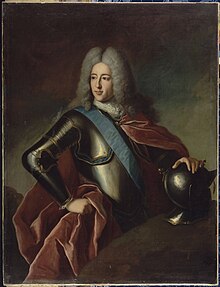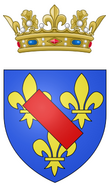Louis IV Henri de Bourbon, prince de Condé
Louis IV. Henri de Bourbon, 7th prince de Condé , or according to other counting Louis Henri I (born August 18, 1692 in Versailles , † January 27, 1740 in Chantilly ), titular duke of Bourbon , duke of Bourbonnais and peer of France , Duke of Enghien and Peer of France, 3rd Duke of Guise and Peer of France, Duke of Bellegarde , Knight of the Royal Orders and of the Golden Fleece , 1710 Grand Master of France ; French nobleman and prince of blood .
Louis Henri, Duke of Bourbon, was Grand Chamberlain of the royal house and Governor of Burgundy . He was after Louis XIV's death while Louis XV was a minor . President of the Regency Council , 1716 President of the Council of War , 1718 Lieutenant-General and was given overall supervision over the upbringing of the young king. In 1721 he became Colonel General of the Infantry. After the death of the Duke of Orléans on December 2, 1723, he became Prime Minister , but ousted by Fleury in 1726 due to his inability and indolence, against whom he conspired without success. He was also the Grand Master of all mines and mines.
Life
Louis Henri was the eldest son of Louis III. de Condé , and Louise Françoise de Bourbon , a legitimate daughter of Louis XIV with Madame de Montespan .
Louis Henri was called Duke von Enghien during his father's lifetime and followed his death in 1710 as the 7th Prince of Condé ( Monsieur le Prince ), but like him never held the title, but was known as Duke of Bourbon ( Monsieur le Duc ). He was clothed with the Order of the Holy Spirit on January 1, 1709 and took his place in the Parlement ( cour des pairs ) on March 19 as a pair of France . After the death of his father on March 4, 1710, he took over his offices and on March 24, he swore his oath of allegiance as Grand Chamberlain of the royal house ( Grand Mâitre de France ) and Governor of Burgundy.
He took part in the campaigns of 1710 and 1711, the sieges of Douay , 1712, Landau and Freiburg , 1713, and stood before Freiburg with the rank of maréchal de camp , although he was killed during a hunt by a careless shot by the Duke of Berry in 1712 had lost the light of one eye.
The will of Louis XIV had made him a member of the Regency Council ( conseil de régence ), but he was only supposed to take his seat after he was 24 years old. This restriction was lifted by the parliament and, despite his youth, even given the chairmanship.
In 1716 he also took over the chairmanship of the council of war after Marshal Villars , who had held this post, resigned in his favor. On March 8, 1718 he became lieutenant-général and received in the lit de justice in June of the same year the supervision of the education of the young king, which had until then had the Duke of Maine . In the same year he bought the county of Clermont-en-Beauvoisis and inherited half of the Duchy of Guise in 1723 from his widowed grandmother, Countess Palatine Anna Henriette von Pfalz-Simmern . He bought the other half in 1727 from his great aunt, the widowed Duchess of Braunschweig-Lüneburg , Benedikta Henriette von Pfalz-Simmern , who received half of the purchase price in cash and the other half as an annuity of 10,000 livres per year until her death in August 1730 .
When the Duke of Orléans died on December 2, 1723 , the prince asked the king for the office of prime minister, which Cardinal Dubois, who had previously deprived him of, received it on the same day.
On June 11, 1726, the prince received a lettre de cachet , which referred him to Chantilly, while Bishop Fleury took over the business as first minister. In 1727 the prince shared with his brothers. He resigned the Count of Clermont with money and left the Duchy of Bourbonnais to the Count of Charolais , which he redeemed in 1730. In the same year the prince, who had been allowed to visit the court again since 1727, was again exiled to Chantilly because of intrigues against the now Cardinal Fleury, but was soon recalled.
He died on January 27, 1740 at his Chantilly castle . In his will he bequeathed 500,000 livres to his natural daughter, Anne-Henriette de Verneuil, and 100,000 livres to the poor. He was buried in the Oratorian Church in Montmorency .
His annual income was 3,000,000 livres, not counting the life annuity of 700,000 livres on his Paris townhouse.
Marriage and offspring
Louis Henri married on July 9, 1713 in Versailles Marie Anne de Bourbon (1689-1720), a daughter of the great Conti , François-Louis de Bourbon, prince de Conti . After her early death, he was half-determined to marry the daughter of the King of Poland, Maria Leszczyńska , but could not part with his mistress, the Marquise de Prie , so that Maria Leszczyńska finally 1725 Louis XV. married and became Queen of France. On July 22, 1728, Louis Henri married fourteen-year-old Caroline Charlotte von Hessen-Rheinfels-Rotenburg (1714–1741), a daughter of Landgrave Ernst Leopold von Hessen-Rheinfels . From this last connection comes his only legitimate child, Louis V Joseph de Bourbon, prince de Condé . Due to the age difference in the marriage, Caroline still had a secret lover, Count Jean-Baptiste-François-Joseph de Sade .
His natural daughter with Armande-Felice de La Porte-Mazarin (1691-1729), Anne-Henriette de Bourbon, mademoiselle de Verneuil , (* Paris April 23, 1725; † Beaumont-les-Tours September 11, 1780), was born in 1734 legitimized and was married to Lieutenant General Jean de La Guiche (1719–1770) since November 17, 1740 .
literature
- Johann Samuelersch , Johann Gottfried Gruber : General Encyclopedia of Sciences and Arts . Volume 19, page 41, sub verbo Condé . Gleditsch, Leipzig 1818.
Individual evidence
- ^ Maurice Lever : Marquis de Sade. The biography. Europaverlag, Vienna et al. 1995, ISBN 3-203-51238-6 , p. 42 f.
| personal data | |
|---|---|
| SURNAME | Bourbon, Louis IV. Henri de, prince de Condé |
| ALTERNATIVE NAMES | Bourbon-Condé, Louis Henri I. de |
| BRIEF DESCRIPTION | French Prince of the Blood, President of the Regency Council, Grand Chamberlain of the Royal House |
| DATE OF BIRTH | August 18, 1692 |
| PLACE OF BIRTH | Versailles |
| DATE OF DEATH | January 27, 1740 |
| Place of death | Chantilly |

